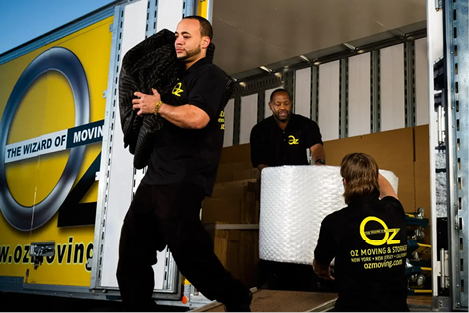Moving During A Remodel – Tips for Builders & Homeowners
As property prices have shot up in recent years, more people than ever seem to be opting for home improvements rather than moving. A temporary move, however, is often necessary.
Though living on-site is treated as a smart cost-cutting decision, moving out often saves homeowners significant discomfort and allows builders to get on with their work more safely and quickly. If you’re considering moving out during your remodel, we’ve broken down the benefits, key tips and tricks, and everything else you need to know to ensure a smooth temporary move.


Why Move During a Remodel?
There are pros and cons to living on-site while renovating. Still, we’d argue that moving out offers significant benefits to both builders and homeowners and ultimately, allows projects to operate more smoothly:
– The Noise: There’s just no escaping renovation noise and it can get frustrating for both builders and homeowners to work around each other on this matter.
– It’s A Safety Issue (especially for kids and pets): We’ve all seen enough concrete steps with paw marks pressed into them to know that building sites do not mix well with kids and pets. There are also serious safety hazards that remodels can pose to child health.
– Privacy Concerns: Domestic routines and lives are inherently private. Unfortunately, it’s also a boundary that remodeling will inevitably erode which gets uncomfortable for both homeowners and builders.
– Outages: Water, electricity, and HVAC systems often need to be switched off while building work is happening. This can be extremely disruptive for anyone trying to live on-site and often can’t be avoided without delaying important renovation work.
– Reduces Delays: Every time a builder is forced to delay an outage or hold off on making noise for the sake of not inconveniencing whoever is living on-site, it ultimately creates delays across the project.
– It’s Better for Builders: When homeowners move out, it makes things so much easier and safer for building teams. They can focus more on getting their job done with fewer distractions and fewer safety concerns for any small humans or animals around.
Planning the Move: Key Considerations
Here’s what builders and homeowners need to take into account when planning a move:
– Budget: Questions like “What does it cost to move?” need to be answered early in the planning as the answer may have an impact on the rest of the renovation budget.
– Schedule in Advance: Ideally, moving should occur before renovations but it may not be possible. Either way, homeowners need to be clear with their builders on when they’ll be moving out so that the renovation work can be adjusted around this.
Best Packing Strategies for Temporary Moves
When it comes to a packing checklist, here are some of the best strategies to use when preparing for a temporary move:
– Declutter First: One of the best ways to simplify packing for a temporary move and indeed, an entire renovation project, is to embark on a strict decluttering mission at least a month or two in advance.
– Disassemble as Much as Possible: Disassembling will save packing space and allow you to transport things more easily.
– Label Everything: Temporary moves usually have a tight turnaround so take extra care to organize and label boxes appropriately. It will make unpacking that much speedier.
– Save Packing Materials: The thing about a temporary move is that you know you’ll be moving again within a few weeks or months so save as much of your packing materials as possible to re-use.
– Check What’s in the New Accommodation: This saves the hassle of accidentally packing unnecessary items.
Coordinating with Builders: Communication Tips
Clear communication between homeowners and builders can make the task of moving out during a renovation that much simpler:
– Clear up Timelines: Make sure there is a clear and agreed-upon timeline with important dates from both sides. If you as a homeowner have a specific date you need to move out or back in, let your builder know so that they can accommodate this as best as possible. They can also help set your expectations more realistically.
– Confirm Things in Writing: Emails and texts should be used to re-confirm plans discussed verbally so that all parties can go back and check information when needed.
- Check-in Regularly: Delays can happen on all sides so make sure to have regular check-ins with your builders.
Choosing a Temporary Living Space
The two most important factors when choosing a temporary living space during a remodel are:
– Proximity to The Build: The closer the better as it will allow homeowners to check in regularly. It also means less disruption to personal schedules, school runs, etc.
– Flexible Leasing: It’s not always possible but if homeowners can stay somewhere with a flexible lease, it means that they can stay on if there are building delays.
Logistics of Moving Back After the Remodel
– Depending on the scale of the remodel, the space that homeowners moved out of likely looks quite different by the time they’re preparing to move back in. One of the main logistics to keep in mind is navigating these changes and where items need to be moved back.
– Homeowners can work with their builders on this to draw up an updated floor plan so that movers then also have a better sense of where boxes or pieces of furniture need to go.
Move Out for a Smoother Move In
– Moving out during a remodel can be a godsend for both homeowners and builders. Homeowners are saved from the struggle of living in dust and construction noise, and builders can get on with their work unhindered. Everybody wins.
If you’re looking for a trusted, full-service moving company who understands the challenges homeowners and builders face when they decide to renovate, visit www.ozmoving.com.
Want more?
Click here for more tips and tools articles written by HBRA Members!


